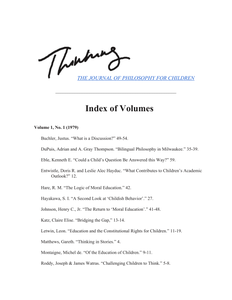The journal was a forum for the work of both theorists and practitioners of philosophical practice with children, and published such work in all forms, including philosophical argument and reflection, classroom transcripts, curricula, empirical research, and reports from the field. The journal also maintained a tradition in publishing articles in the hermeneutics of childhood, a field of intersecting disciplines including cultural studies, social history, philosophy, art, literature and psychoanalysis.
DOCUMENT

“Municipal Youth Work taken over by Christians”. (Binnenlands Bestuur, 2009) This heading refers to the work of Youth for Christ in an Amsterdam neighbourhood. This organisation, successful in Youth Work nationwide, last year came out first in an open competition of the Amsterdam district De Baarsjes. Because of this they were commissioned to undertake all the youth work in this multicultural neighbourhood. The conditions were not to evangelise and not to limit recruitment of personnel inside their own circle but to recruit from outside the organisation as well. When they later appeared to have put a job advertisement only on their own website, this led to heated debates. Finally Youth for Christ acknowledged and rectified this mistake. This example is a concrete illustration of the actual and sometimes delicate relationships between philosophy of life and social work
DOCUMENT

The design of healthcare facilities is a complex and dynamic process, which involves many stakeholders each with their own set of needs. In the context of healthcare facilities, this complexity exists at the intersection of technology and society because the very design of these buildings forces us to consider the technology–human interface directly in terms of living-space, ethics and social priorities. In order to grasp this complexity, current healthcare design models need mechanisms to help prioritize the needs of the stakeholders. Assistance in this process can be derived by incorporating elements of technology philosophy into existing design models. In this article, we develop and examine the Inclusive and Integrated Health Facilities Design model (In2Health Design model) and its foundations. This model brings together three existing approaches: (i) the International Classification of Functioning, Disability and Health, (ii) the Model of Integrated Building Design, and (iii) the ontology by Dooyeweerd. The model can be used to analyze the needs of the various stakeholders, in relationship to the required performances of a building as delivered by various building systems. The applicability of the In2Health Design model is illustrated by two case studies concerning (i) the evaluation of the indoor environment for older people with dementia and (ii) the design process of the redevelopment of an existing hospital for psychiatric patients.
DOCUMENT
